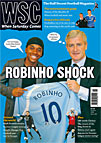 The Russian League plan to switch to playing through the winter, but James Appell wonders if anyone checked the weather forecast
The Russian League plan to switch to playing through the winter, but James Appell wonders if anyone checked the weather forecast
Russia in winter is not an especially pleasant place, even when you’re wearing a thick coat. It can’t be any better wearing football kit. But the Russian Football Premier League (RFPL) have in recent years been considering moving the season of the top two divisions from summer to winter, in keeping with the majority of Europe’s major championships. Russia’s footballers will have been phoning through orders for thermal underwear since July 29 when the RFPL officially unveiled the plan to switch to an autumn-spring season by 2012. “The most important of our goals is the move to an autumn-spring system,” RFPL president Sergey Pryadkin told the press. “It’s difficult to give a fixed time-frame at this moment, but we expect this to occur in an even-numbered year where there will be a break for the European Championship or World Cup. It’s possible that it will be 2012. This is the way forward from a commercial point of view.”
The announcement provoked more questions than answers. Pryadkin said the plan would encompass both the Russian Premier League and First Division, but could not go into details on how facilities at each of the 36 clubs in these leagues would be improved to allow matches to take place during the harsh winters. Moscow, where the best facilities and available investment generally lie, is a case in point: grounds in the city are barely ready for the summer season, never mind winter. Dinamo Stadium, for example, is fantastic on a nice summer’s day but three of the four stands lack roofs. Meanwhile the Luzhniki Stadium, where Spartak and CSKA play home matches, has an astroturf pitch even for the summer season. The turf brought in from Slovakia for May’s Champions League final was torn up soon after the game.
Then there are the venues outside the Russian capital. In Vladivostok, a city on the Pacific Ocean within touching distance of Japan, the Premier League side Luch‑Energiya have been struggling with their pitch all season. Unseasonal rains have turned the grass into a swamp and the team have been warned that any future problems would result in matches being taken away from the stadium. It is anyone’s guess how a season of winter football would affect the playing surface.
Also in the Premier League at the moment are Tom, from the city of Tomsk in Eastern Siberia. The average temperature in January in the city is between -21º and ‑19º C. In January 1996 the city hit a record low temperature of -56º C. To be able to hold football matches, the Trud Stadium in Tomsk would clearly need an overhaul – heating in the stands as well as under the soil, and a lot of volunteers to shovel snow.
The issue has divided professional opinion. Kurban Berdyev, coach of championship contenders Rubin Kazan, is against: “It’s hardly realistic. There are plans for stadiums with roofs and warm air circulating around the stands, but it’s extremely expensive. And how will they play in minus 15 or 20? What kind of supporter is going to sit in the stands?” On the other hand, Russia goalkeeper and CSKA captain Igor Akinfeev is more receptive to the idea, as it would allow players to have a proper post-season break. “If it happens I’ll be very happy,” he said. “Honestly, three months of training camps are too long. This year, for example, I flew first to the Emirates, then to Spain… two months I was away from home. We have these two- or three-month training camps, then the championship begins, so basically the season begins in winter and ends in winter. You play all year round, holidays are 20 days maximum.”
Vanya Lidsky, a 22-year-old Spartak Moscow fan, thinks the whole idea is crazy, though. “It’s the stupidest thing I’ve ever heard. There’s this Second Division team in the far north, Sever Murmansk. It’s in the Arctic Circle. Are they supposed to play in winter there if they get promoted?”
One hopes the RFPL have a plan for every eventuality – and that it’s not just an enormous shipment of orange footballs.
From WSC 260 October 2008